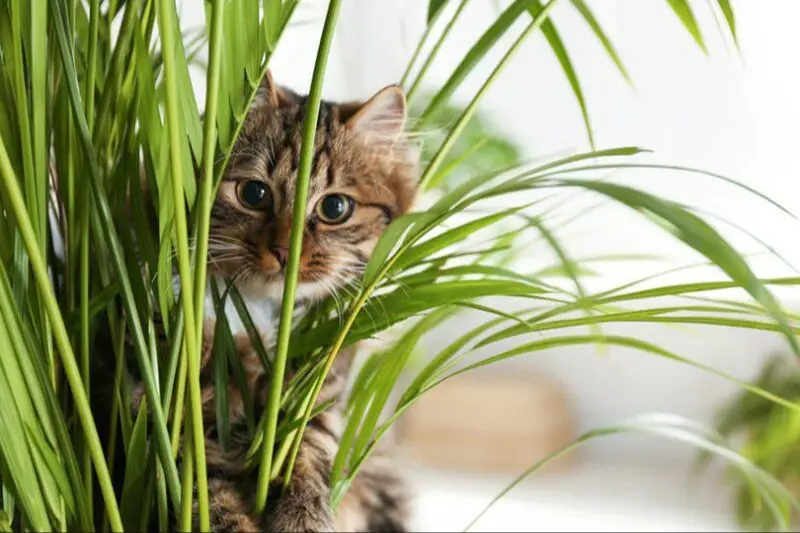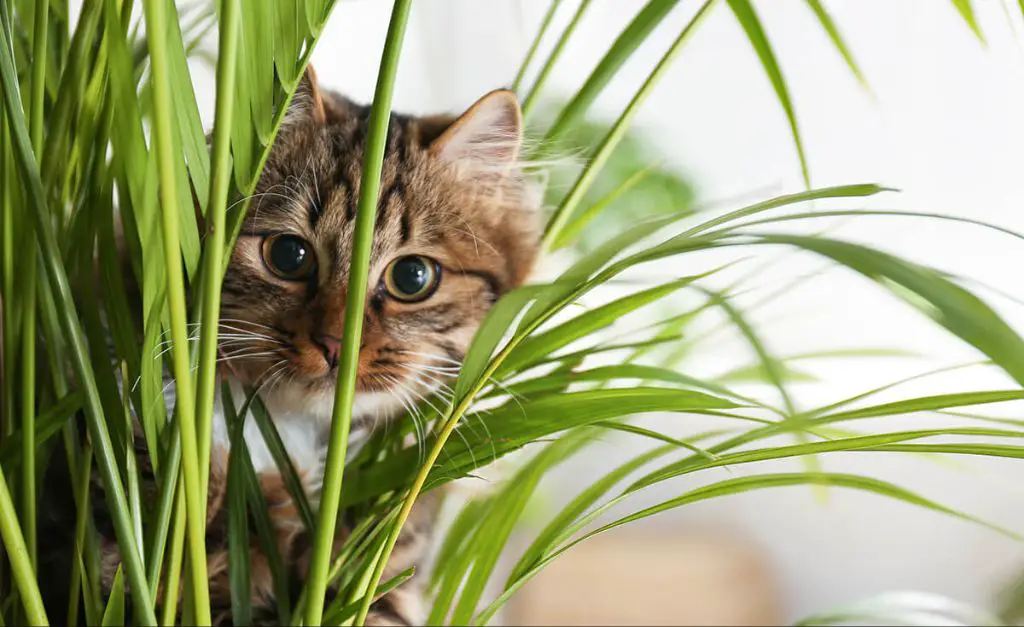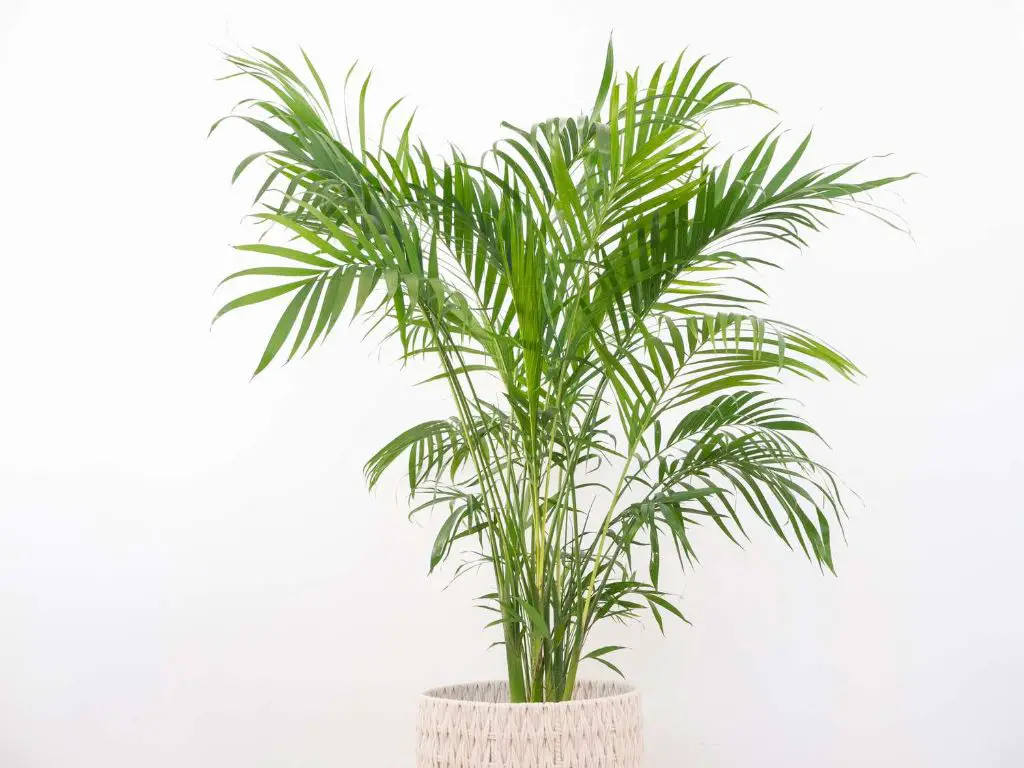With their striking fan-like leaves and tropical appearance, cat palm plants are a popular indoor choice that can spruce up any home decor. However, cat palms have also gained notoriety for their potential toxicity to feline friends. This has left many cat owners wondering – just how safe are these plants for cats? While they can pose some risks, proper precautions can allow cat palms and cats to coexist peacefully.
In this article, we’ll cover everything you need to know about cat palm toxicity. We’ll explore which parts of the plants are dangerous, what symptoms to watch for, and how to treat exposure. We’ll also provide tips on keeping your curious kitties safe. By the end, you’ll have the knowledge to grow cat palms safely so everyone – both human and cat – can enjoy their beauty.
What Are Cat Palms?
Cat palms are a popular type of indoor palm plant in the genus Chamaedorea. Their botanical name is Chamaedorea cataractarum. They are native to Mexico and are characterised by their long, graceful, arching fronds that resemble feathers or cat tails. The palm leaves emerge from multiple thin stems growing from a central base.
There are around 10-12 species in the cat palm genus Chamaedorea, but Chamaedorea cataractarum is the most commonly grown houseplant. They are often called cat palm, cat tail palm, cats paw, or false castanospermum. Some other common names refer to where they originate from, like Mexican palm or Belize palm.
These compact palms have an attractive, tropical look and gracefully arching leaves that make them popular indoor plants. They have a relatively slow growth rate and only reach about 3-4 feet tall indoors. Cat palms do best in bright, indirect light and high humidity. They can be sensitive to overwatering and low humidity.
Are Cat Palms Toxic to Cats?
Yes, cat palms are toxic to cats if ingested. The ASPCA lists cat palms (also known as cascade palms or Chamaedorea cataractarum) as toxic to cats and dogs if eaten [1]. All parts of the cat palm contain calcium oxalate crystals which can cause oral irritation, excessive drooling, vomiting, difficulty swallowing, and intense burning and irritation of the mouth, lips, tongue, and throat if ingested.

While cat palms are toxic, they are not often fatal since cats need to ingest a large amount to cause serious harm. Minor ingestion may cause temporary discomfort or vomiting. However, the ASPCA does classify cat palms as level 2 or 3 out of 4 in toxicity, meaning they can cause more moderate to severe symptoms if enough of the plant is eaten.
Cat owners should take care to keep cat palms out of reach of curious cats who may be tempted to chew on the leaves and stems. Precautions should also be taken if the cat palm is actively shedding pollen or seeds which a cat could then ingest while grooming.
Toxic Parts of the Cat Palm
While the cat palm itself is not poisonous to cats, certain parts of the plant contain toxins that can cause illness if ingested in large quantities. According to Planet Natural, the main toxic compound found in cat palms is called saponins, which are naturally occurring steroids that have soap-like qualities https://www.planetnatural.com/cat-palm/. Saponins are found in the leaves, stems, and roots of the cat palm.
Cats that ingest saponins may experience vomiting, diarrhea, and lethargy. Saponins have a bitter, unpleasant taste that deters most pets from consuming large amounts. However, cats may still nibble on the leaves and stems out of curiosity. While a small amount likely won’t cause issues, ingesting saponins repeatedly over time can potentially lead to toxicity.
To keep cats safe, it’s recommended to place cat palms out of reach or provide alternative surfaces and plants they can nibble safely. Prune away dead leaves and remove any fallen plant matter promptly. Supervise cats around cat palms and redirect them if they attempt to eat the plant.
Symptoms of Cat Palm Poisoning
Symptoms of cat palm poisoning usually develop within a few hours of ingesting parts of the plant. The most common symptoms include:
- Vomiting – One of the hallmark signs of cat palm poisoning in cats is repeated vomiting. Cat palms contain toxins that can irritate the gastrointestinal tract, triggering vomiting.
- Diarrhea – Ingesting toxic parts of cat palms can also lead to profuse, watery diarrhea in cats. The toxins irritate the digestive tract, inducing diarrhea to flush out the toxins.
- Lethargy – Cats suffering from cat palm poisoning often become increasingly lethargic. The toxins make cats feel unwell, and they lose energy and motivation to move around.
In rare cases, cat palm poisoning can also cause weakness, tremors, seizures and liver damage in cats. However, vomiting and diarrhea are the most common symptoms seen.
If a cat shows signs of vomiting, diarrhea or lethargy after ingesting parts of a cat palm plant, it’s important to immediately contact your veterinarian. Quick treatment can help manage symptoms and prevent serious complications.
Treatment for Cat Palm Poisoning
If a cat has ingested parts of a cat palm plant, it is crucial to seek veterinary care immediately. However, there are some initial steps that can be taken at home before getting to the vet:
Inducing vomiting may help eliminate some of the toxin before it is absorbed into the bloodstream. This can be done by administering 3% hydrogen peroxide orally. The dosage is 1 teaspoon per 5 lbs of the cat’s body weight, up to 3 tablespoons maximum. Consult with a vet before inducing vomiting.

Activated charcoal may also help absorb some of the toxins. This can be administered orally if the cat is alert. The typical dosage is 1-4 g per kg of body weight every 4-6 hours. Again, consult a vet first for the proper dosage.
Once at the vet’s office, they will likely induce vomiting again or pump the stomach to fully eliminate any remaining plant parts. Intravenous fluids will help flush the toxins from the cat’s system. Other medication may be given to control vomiting and protect the liver from damage by the toxins (Source: https://www.poison.org/). With prompt treatment, many cats fully recover from cat palm poisoning.
Preventing Exposure
Keeping cat palms out of reach is the best way to prevent exposure. Here are some tips:
- Place cat palms on high shelves or surfaces that cats can’t access.
- Keep cat palms in rooms that cats are not allowed in, and keep the doors closed.
- Consider putting cat palms outside on the patio or deck if you have outdoor space.
- Hang cat palms using hooks or wall planters so they are not within your cat’s reach.
- Spritz cat palms with orange, lemon or grapefruit essential oils which cats dislike.
- Use pet repellent sprays made with natural ingredients around the base of the plant.
- Cover the soil surface with corks or large pebbles to prevent digging.
With some creative thinking and planning, you can find ways to keep your cat safe while still enjoying beautiful cat palms in your home.
Cat-Safe Houseplants
While some popular houseplants like cat palms can be toxic to cats, there are many safe alternatives to consider. Here are some great cat-friendly houseplant options:

Spider Plants – With long, green leaves and curly white strands, spider plants are a safe choice for cats. According to the ASPCA, spider plants are non-toxic for cats, dogs, and horses. Spider plants can help purify indoor air and only need moderate sunlight and watering. They are easy to care for and propagate as well. (Source)
Ponytail Palms – These unique plants feature a thick, trunk-like stem and long, curly leaves, resembling a ponytail. Ponytail palms are non-toxic for cats according to the ASPCA. They tolerate low-light conditions well but prefer bright, indirect light. Let them dry out between waterings. They make interesting statement plants with a tropical vibe. (Source)
Prayer Plants – Prayer plants have beautiful green leaves marked with white, pink, or red veining, depending on variety. They get their name from the way their leaves fold up at night, like praying hands. These tropical plants thrive in high humidity. Prayer plants are non-toxic and pet-friendly. (Source)
When to See a Vet
If your cat shows any symptoms after being exposed to a cat palm plant, it’s important to seek veterinary care immediately. According to Poison Control, cats who ingest toxic plants may show signs of poisoning within 2 hours. Therefore, if you know or suspect your cat has eaten part of a cat palm, monitor them closely and don’t wait for symptoms to worsen before contacting your vet.
Some symptoms that warrant an urgent vet visit include: vomiting, diarrhea, drooling, difficulty swallowing, lethargy, weakness, tremors, seizures, and collapse. Your vet can induce vomiting if ingestion was recent, provide IV fluids and medication to control vomiting and diarrhea, and monitor your cat’s organ function.
Bring a sample of the plant with you to the vet appointment, if possible, to aid in identification and proper treatment. Timely vet care can mean the difference between a full recovery or long-lasting health issues for your cat after cat palm poisoning. According to Olympia Pet Emergency, most cats recover within 24-48 hours when properly treated. However, kidney or liver damage is possible if a cat consumes a significant amount of a toxic plant.
Conclusion
To summarize the key points: Cat palms are highly toxic to cats if ingested. The plant contains insoluble calcium oxalates that can cause painful swelling, vomiting, difficulty breathing, and severe chemical burns if eaten. Immediately contact your veterinarian if you suspect your cat has ingested any part of the cat palm. There is no antidote, so treatment focuses on managing symptoms and ensuring your cat can breathe properly.

To keep your feline companions safe, avoid bringing cat palms into your home if you have cats. Opt for cat-friendly alternatives like spider plants, ponytail palms, or parlor palms instead. Watch for signs of chewing or eating houseplants and keep all houseplants out of reach of cats.
While cat palms are beautiful plants, they simply aren’t worth the risk for cat owners. Don’t put your cat’s health and safety at risk. When in doubt, leave the cat palm out.

